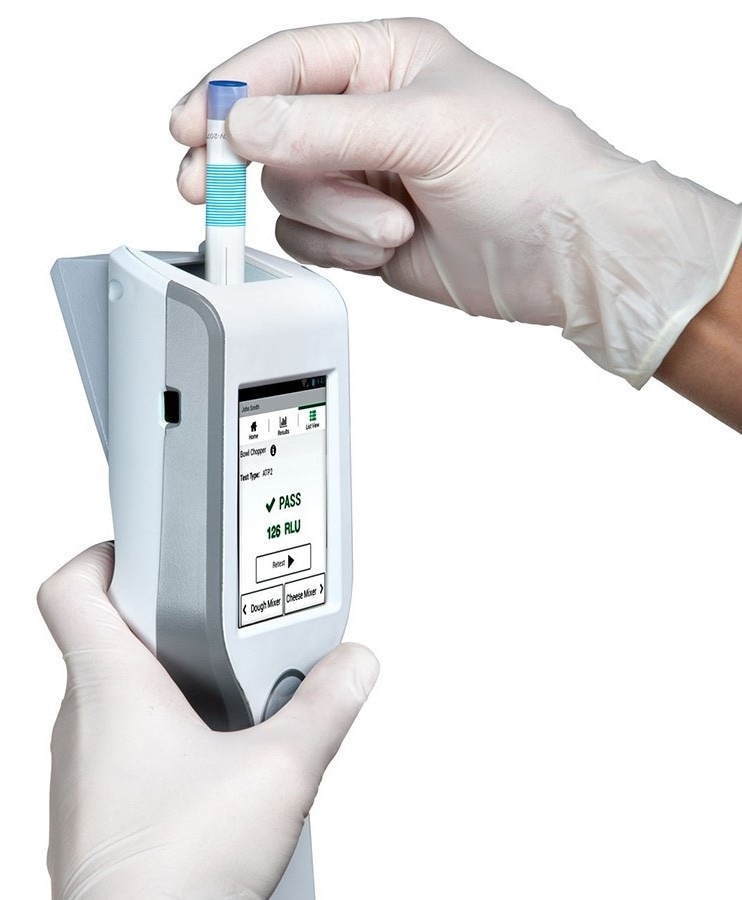According to a new study from food scientists at Cornell University, spoilage and foodborne illness could be reduced by using specially designed rapid-testing adenosine triphosphate (ATP) swabs to clean surfaces in commercial food processing facilities. ATP swabs create a light, which is analogous to the glow of fireflies in the presence of microbes.

A food safety professional uses the 3M Clean-Trace luminometer to read a swab. Image Credit: Cornell University.
At the time of food production, regular cleaning and surface sanitation are crucial to prevent the contamination of microorganisms in the final food products. In the absence of this sanitation procedure, food from processing facilities can become more susceptible to spoilage, and individuals who consume that food have a higher risk of death or illness from foodborne pathogens.
Food scientists know that for processing plants, visual inspection is not a reliable indicator of cleaning-protocol success. All food factory ‘ecosystems’ are prone to niches where microorganisms can hang out or where food residues can persist. We need to find them.”
Randy Worobo, Professor of Food Science, College of Agriculture and Life Sciences, Cornell University
Worobo is also a faculty fellow from the Cornell Atkinson Center for Sustainability.
He is the senior author of the study titled “Implementation of ATP and Microbial Indicator Testing for Hygiene Monitoring in a Tofu Production Facility Improves Product Quality and Hygienic Conditions of Food Contact Surfaces: A Case Study,” which was published in Applied and Environmental Microbiology journal on February 12th, 2021.
According to the U.S. Centers for Disease Control and Prevention, foodborne pathogens affect over 48 million Americans each year; in fact, over 120,000 individuals are hospitalized and around 3000 persons die.
Worobo and Jonathan H. Sogin, the study lead author and doctoral student in food science, assessed the efficacy of an environmental monitoring program utilizing the 3M Clean-Trace Hygiene Monitoring and Management system for ATP monitoring, along with 3M Petrifilm Plates, for microbiological enumeration.
The duo teamed up with 3M Food Safety microbiologists and spent nine months testing the specimens obtained from the processing environment in a commercial tofu manufacturing plant.
Worobo, Sogin, and the 3M Food Safety group devised a customized strategy to utilize an ATP swab test to analyze many crucial points in the plant once it had been cleaned. As soon as the ATP swab is used, it is positioned in a luminometer instrument in which the bioluminescence of contaminants is identified.
The proportion of light is converted in the luminometer to comparative light units, where this value is shown on the instrument. If it goes beyond a defined threshold value, the surface would be deemed dirty and may signify that cleaning operations were not properly carried out.
Results demonstrate that targeted cleaning—revealed by ATP monitoring and validated by additional microbiological tests—can enhance the environmental hygiene of food-processing facilities.
If a plant supervisor is responsible for the cleaning crew and the supervisor says, ‘That’s not clean enough,’ there might be an employee who thinks that the supervisor is picking on them. Instead, if you have luminometer, like the 3M Clean-Trace system, that device removes the bias so that the cleaning crew itself can see the numbers. These methods become a quantitative way to ensure that they’re doing a good job.”
Randy Worobo, Professor of Food Science, College of Agriculture and Life Sciences, Cornell University
Microbiological enumeration and ATP monitoring can validate and enhance the efficacy of sanitation and cleaning practices, which can have a positive effect on both the facility and the product quality, stated Sogin.
This test can not only verify that the plant’s equipment and food-contact surfaces are cleaned and sanitized before starting food preparations, it can identify problematic situations. It helps you become a sleuth. But as a standard, the industry should be using this method to verify cleaning and sanitation programs. It’s key.”
Randy Worobo, Professor of Food Science, College of Agriculture and Life Sciences, Cornell University
Source:
Journal reference:
Sogin, J. H., et al. (2021) Implementation of ATP and Microbial Indicator Testing for Hygiene Monitoring in a Tofu Production Facility Improves Product Quality and Hygienic Conditions of Food Contact Surfaces: a Case Study. Applied and Environmental Microbiology. doi.org/10.1128/AEM.02278-20.